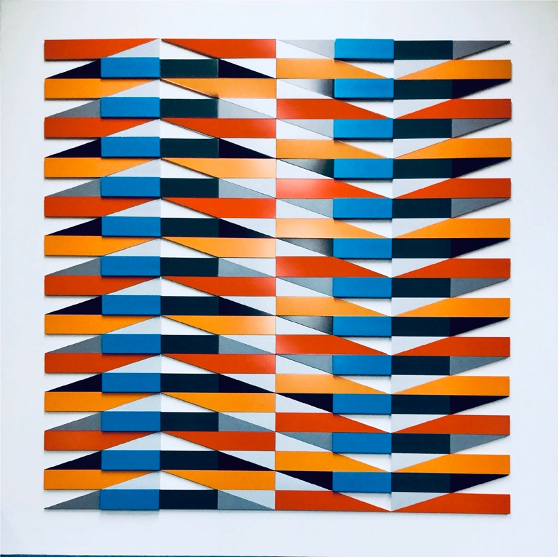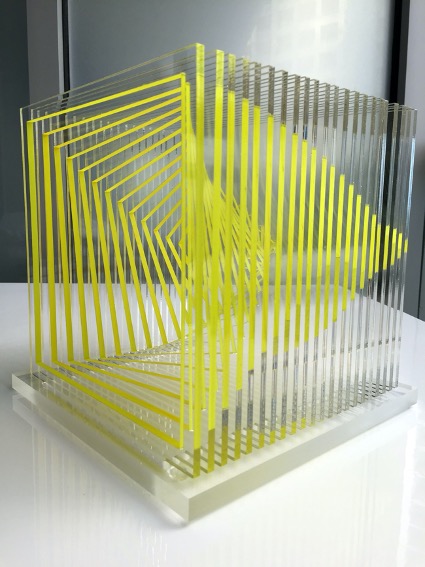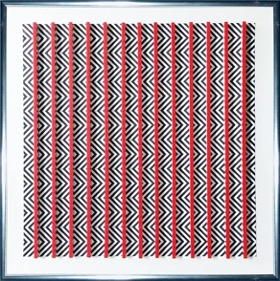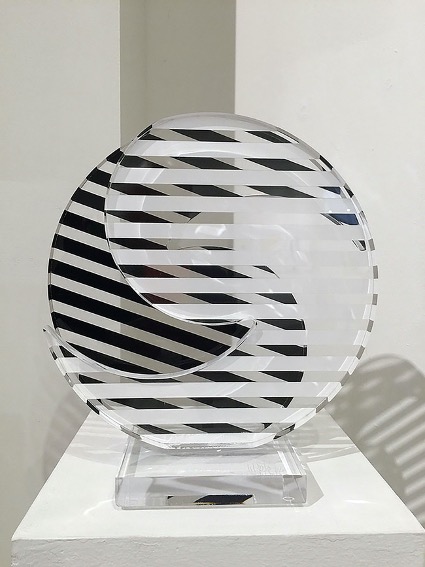When shapes dance, the art creates
Anonymous

Wuilfredo Soto and the Interrelation in Series of Lines
By Lieska Husband Sosa
February 15 th , 2020
Movement, perception, and optical illusion, are the three concepts connected in Wuilfredo
Sotos’s artwork. Rhythmic variations of a Latin America geometric tradition that has always
endured in the collective memory but with the imprint of new times. Born in the context
where abstract language becomes omnipresent, his references to Jesus Soto and Carlos
Cruz-Diez mark the imprint of his work under the reinterpretation of line, shape and color.
The theme is not new but the way of interpreting is.
The artist, a studious and tireless researcher, tells me about his tastes for Russian
Constructivism of the early 20 TH century, the exalted colorful of Gauguin and much closer
in time the interaction of color according to Josef Albers; the Kinetic Art of the 50’s with the
versatility of Jesus Soto, the vibrancy of Cruz-Diez, the optical illusion of Le Parc and
Vasarely or the industrial design of Neal Small in the 70’s. All those sources nourish a
work that retakes, reinterprets and makes concepts and legacies of its own.
Wuilfredo Soto’s artwork runs with equal skill between the two or three-dimensionality
where the apparent simplicity of lines in some cases, joins a formal minimalism with
impeccable assembly. His series rhythmic compositions sometimes accentuated by a
polychrome charged with light, are an ode to movement.

Soto is an artist of his time and the use of materials combined with technology, are
sources that when used it an ingenious way, result in a coherent body of work based on
the premise of study and research. The use of laser and CNC router as cutting tools in soft
and rigid materials, allows him to model parts in two and three dimensions with the help of
the computer as a working instrument. It is a process of creation with millimeter precision
in which the cuts and cavities in wood, MDF, acrylic or expanded PVC, as well as in
aluminum or stainless steel, gives shape to the piece that will later be lacquered ‒if
necessary‒ and assembled by hand. It is almost a magical way of sculpting the material.
Geometry and mathematics play predominant role In Wuilfredo Soto’s serial structures.
His work lies beneath the aesthetic of the scientific and the rationally structured. Both,
chromatic interaction with mathematical precision, stimulate the contemplative game of the

spectator, who perceives movements, vibrations or deviations in a static body of art.
Infinite creative possibilities are born from the interrelation of these lines arranged on the
material’s surface.
In some of these pieces, the translucency of the material (Plexiglas or acrylic) adds
another way of interpreting or visualizing the experience. For instance, in three-
dimensional artworks the artist superimposes acrylic sheets in which he draws with laser,
geometrical structures arranged in a specific order and embedded in calibrated acrylic
base, creating volumes with voids toward the interior of the piece that can be observed
through of the different layers of the material.
Wuilfredo Soto has been able to look into the vast field of the abstraction with a visual
proposal that runs between research and creative process calculated to the millimeter.
Noting is left to chance. He is a studious of the movement of each of the elements that
make up his work and from the dimension of color, adds chromatic harmony. The viewer
then, enjoys picking up the artistic fact from his own interpretation, immersing himself in a
playful, colorful and dynamic adventure.
Note: Images at www.wuilfredosoto.com




